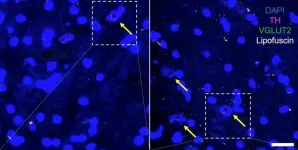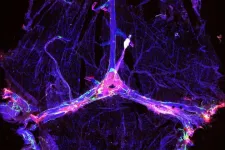(Press-News.org) It's one of the most audacious projects in biology today - reading the entire genome of every bird, mammal, lizard, fish, and all other creatures with backbones.
And now comes the first major payoff from the Vertebrate Genome Project (VGP): near complete, high-quality genomes of 25 species, Howard Hughes Medical Institute (HHMI) Investigator Erich Jarvis with scores of coauthors report April 28, 2021, in the journal Nature. These species include the greater horseshoe bat, the Canada lynx, the platypus, and the kākāp? parrot - one of the first high-quality genomes of an endangered vertebrate species.
The paper also lays out the technical advances that let scientists achieve a new level of accuracy and completeness and paves the way for decoding the genomes of the roughly 70,000 vertebrate species living today, says HHMI Investigator and study coauthor David Haussler, a computational geneticist at the University of California, Santa Cruz (UCSC). "We will get a spectacular picture of how nature actually filled out all the ecosystems with this unbelievably diverse array of animals."
Together with a slew of accompanying papers, the work is beginning to deliver on that promise. The project team has discovered previously unknown chromosomes in the zebra finch genome, for example, and a surprise finding about genetic differences between marmoset and human brains. The new research also offers hope for saving the kākāp? and the endangered vaquita dolphin from extinction.
"These 25 genomes represent a key milestone," explains Jarvis, VGP chair and a neurogeneticist at The Rockefeller University. "We are learning a lot more than we expected," he says. "The work is a proof of principle for what's to come."
From 10K to 70K
The VGP milestone has been years in the making. The project's origins date back to the late-2000s, when Haussler, geneticist Stephen O'Brien, and Oliver Ryder, director of conservation genetics at the San Diego Zoo, figured it was time to think big.
Instead of sequencing just a few species, such as humans and model organisms like fruit flies, why not read the complete genomes of ten thousand animals in a bold "Genome 10K" effort? At the time, though, the price tag was hundreds of millions of dollars, and the plan never really got off the ground. "Everyone knew it was a great idea, but nobody wanted to pay for it," recalls HHMI Investigator and HHMI Professor Beth Shapiro, an evolutionary biologist at UCSC and a coauthor of the Nature paper.
Plus, scientists' early efforts at spelling out, or "sequencing," all the DNA letters in an animal's genome were riddled with errors. In the original approach used to complete the first rough human genome in 2003, scientists chopped up DNA into short pieces a few hundred letters long and read those letters. Then came the fiendishly difficult job of assembling the fragments in the right order. The methods weren't up to task, resulting in misassemblies, major gaps, and other mistakes. Often it wasn't even possible to map genes to individual chromosomes.
The introduction of new sequencing technologies with shorter reads helped make the idea of reading thousands of genomes possible. These rapidly developing technologies slashed costs but also reduced quality in genome assembly structure. Then in 2015, Haussler and colleagues brought in Jarvis, a pioneer in deciphering the intricate neural circuits that let birds trill new tunes after listening to others' songs. Jarvis had already shown a knack for managing big, complex efforts. In 2014, he and more than a hundred colleagues END
Project to read genomes of all 70,000 vertebrate species reports first discoveries
2021-04-28
ELSE PRESS RELEASES FROM THIS DATE:
UChicago scientists harness molecules into single quantum state
2021-04-28
Researchers have big ideas for the potential of quantum technology, from unhackable networks to earthquake sensors. But all these things depend on a major technological feat: being able to build and control systems of quantum particles, which are among the smallest objects in the universe.
That goal is now a step closer with the publication of a new method by University of Chicago scientists. Published April 28 in Nature, the paper shows how to bring multiple molecules at once into a single quantum state--one of the most important goals in quantum physics.
"People have been trying to do this for decades, so we're very excited," said senior author Cheng Chin, a professor of physics at UChicago who said he has wanted ...
Protein linked to sex differences in age-related dopamine neuron loss
2021-04-28
PITTSBURGH, April 28, 2021 - It is not every day that scientists come across a phenomenon so fundamental that it is observed across fruit flies, rodents and humans.
In a paper published today in Aging Cell, neuroscientists from the University of Pittsburgh Schools of the Health Sciences discovered that a single protein--a glutamate transporter on the membrane of vesicles that carry dopamine in neurons--is key to regulating sex differences in the brain's vulnerability to age-related neuron loss.
The protein--named VGLUT--was more abundant in dopamine neurons of female fruit flies, rodents and human beings than in males, correlating with females' greater resilience to age-related neuron loss and mobility deficiencies, the researchers found. Excitingly, ...
Childhood air pollution exposure linked to poor mental health at age 18
2021-04-28
DURHAM, N.C. -- A multidecade study of young adults living in the United Kingdom has found higher rates of mental illness symptoms among those exposed to higher levels of traffic-related air pollutants, particularly nitrogen oxides, during childhood and adolescence.
Previous studies have identified a link between air pollution and the risk of specific mental disorders, including depression and anxiety, but this study looked at changes in mental health that span all forms of disorder and psychological distress associated with exposure to traffic-related air pollutants.
The findings, which will appear April ...
Draining brain's debris enhances Alzheimer's therapies in mice
2021-04-28
Experimental Alzheimer's drugs have shown little success in slowing declines in memory and thinking, leaving scientists searching for explanations. But new research in mice has shown that some investigational Alzheimer's therapies are more effective when paired with a treatment geared toward improving drainage of fluid -- and debris -- from the brain, according to a study led by researchers at Washington University School of Medicine in St. Louis.
The findings, published April 28 in the journal Nature, suggest that the brain's drainage system -- known as the meningeal lymphatics -- plays a pivotal but underappreciated role in neurodegenerative disease, and that repairing faulty drains could be a key to unlocking the potential of certain Alzheimer's therapies.
"The ...
Is forest harvesting increasing in Europe?
2021-04-28
Is forest harvesting increasing in Europe? Yes, but not as much as reported last July in a controversial study published in Nature.
The study Abrupt increase in harvested forest area over Europe after 2015, used satellite data to assess forest cover and claimed an abrupt increase of 69% in the harvested forest in Europe from 2016. The authors, from the European Commission's Joint Research Centre (JRC), suggested that this increase resulted from expanding wood markets encouraged by EU bioeconomy and bioenergy policies. The publication triggered a heated debate, both scientific ...
Assessment of length, readability of informed consent documents for COVID-19 vaccine trials
2021-04-28
What The Study Did: Length, readability and complexity of informed consent documents for the COVID-19 vaccine phase III randomized clinical trials were assessed in this quality improvement study.
Authors: Ezekiel J. Emanuel, M.D., Ph.D., of the University of Pennsylvania in Philadelphia, is the corresponding author.
To access the embargoed study: Visit our For The Media website at this link https://media.jamanetwork.com/
(doi:10.1001/jamanetworkopen.2021.10843)
Editor's Note: The article includes conflict of interest and funding/support disclosures. Please see the article for additional information, including other authors, author ...
Trends in US internal medicine residency, fellowship applications during COVID-19 pandemic
2021-04-28
What The Study Did: The number of applicants and number of applications submitted per applicant to internal medicine residency and subspecialty fellowships for 2021 during the COVID-19 pandemic were compared with five prior application cycles in this study.
Authors: Laura A. Huppert, M.D., of the University of California, San Francisco, is the corresponding author.
To access the embargoed study: Visit our For The Media website at this link https://media.jamanetwork.com/
(doi:10.1001/jamanetworkopen.2021.8199)
Editor's Note: The article includes ...
Racial/ethnic disparities of suicide prediction models after mental health visits
2021-04-28
What The Study Did: Researchers evaluated racial/ethnic differences in the performance of statistical models that use health record data to predict the risk of suicide after an outpatient mental health visit.
Authors: R. Yates Coley, Ph.D., of the Kaiser Permanente Washington Health Research Institute in Seattle, is the corresponding author.
To access the embargoed study: Visit our For The Media website at this link https://media.jamanetwork.com/
(10.1001/jamapsychiatry.2021.0493)
Editor's Note: The article includes conflict of interest and funding/support disclosures. Please see the article for additional information, including other authors, author contributions and affiliations, conflict of interest ...
Examining association between gender-affirming surgeries, mental health outcomes
2021-04-28
What The Study Did: The association between undergoing gender-affirming surgery and mental health outcomes was looked at in this study.
Authors: Anthony N. Almazan, B.A., of Harvard Medical School in Boston, is the corresponding author.
To access the embargoed study: Visit our For The Media website at this link https://media.jamanetwork.com/
(doi:10.1001/jamasurg.2021.0952)
Editor's Note: The article includes conflict of interest and funding/support disclosures. Please see the article for additional information, including other authors, author contributions and affiliations, conflict of interest and financial disclosures, and funding and support.
INFORMATION:
Media advisory: The full study and commentary ...
Brain's waste removal system may offer path to better outcomes in Alzheimer's therapy
2021-04-28
Enhancing the brain's lymphatic system when administering immunotherapies may lead to better clinical outcomes for Alzheimer's disease patients, according to a new study in mice. Results published April 28 in Nature suggest that treatments such as the immunotherapies BAN2401 or aducanumab might be more effective when the brain's lymphatic system can better drain the amyloid-beta protein that accumulates in the brains of those living with Alzheimer's. Major funding for the research was provided by the National Institute on Aging (NIA), part of the National Institutes of Health, and all study data is now freely available ...



